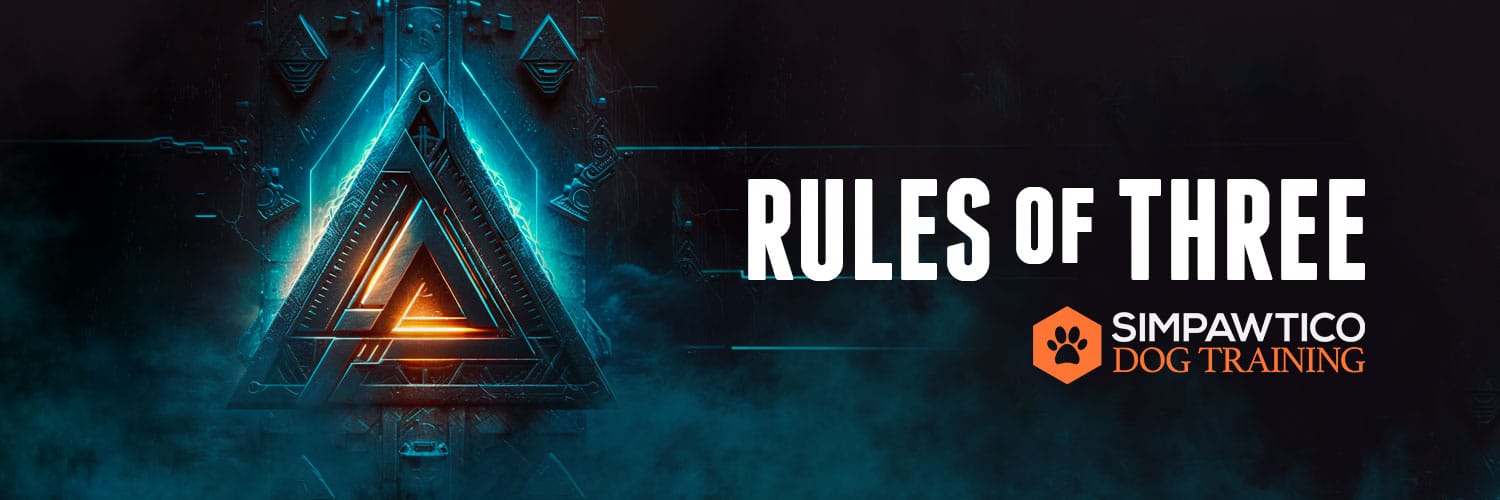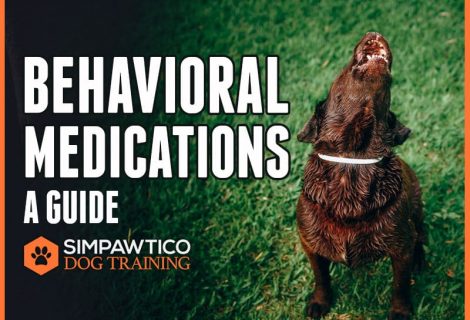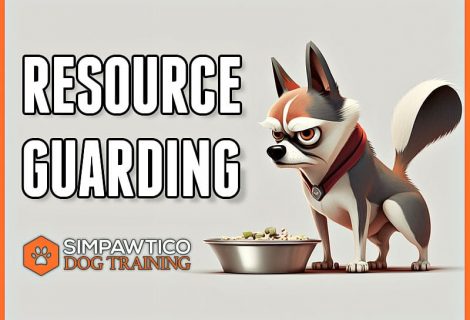Whether it’s some strange pattern in the universe or because we’re just weirdos, we always see threes cropping up. We’ve collected what we think are the most important rules of three in dog training to remember as you work with your doggie. These are presented in a list format with various links to explore more.
Rules of Three in Dog Training


Timing • Criteria • Rate of Reinforcement
This is sometimes called the “Bailey Trinity,” as it was first outlined by Bob Bailey, a giant in applied animal psychology and one of the world’s foremost animal trainers. The three factors of training are important for ALL organisms, not just animals. B.F. Skinner—the father of Operant Conditioning—and his graduate students Marian and Keller Breland (Marian later married Bob Bailey), proved that any organism with a nervous system will respond to Operant Conditioning. The three factors here are not new to Bailey, although he’s written about how crucial the three, in concert, are to effective behavior modification.
Bailey has especially spoken about why designing a focused session is important. Many owners have a “shotgun” approach to practice (if they practice at all) and consequently get shoddy results. It’s much better to have a few laser-focused sessions instead of a bunch of sloppy ones.
We try not to make things too technical for our students, but keeping these three important pieces in mind is still a good way to directionalize your training sessions. If we go in with set criteria for the session, provide immediate feedback, and provide a high rate of reinforcement, our sessions will move quickly with better results.

“Am I safe?” • “What’s the meaning of this?” • “What do I do?”
Every organism mentally runs through these three questions. Not literally, of course, but these questions outline a model—in order—for the needs of any individual as they navigate their environment.
“Am I safe?” The first question is based purely in survival. Based on the individual’s neuroception, this question must be satisfied before the other two can be addressed. This is where hazard avoidance may kick in, potentially bringing the sympathetic nervous system online. Most training approaches focus on satisfying the latter two questions (primarily, the third). However, we must understand that “most training approaches” aren’t where you need to start if a dog is still hung up on this very first question.
“What’s the meaning of this?” The second question attempts to decode the context. What’s happening in the environment? What conditions do I recognize? The learner actively analyzes the environment, determining what’s meaningful and relevant from all stimuli. By doing this, they can develop more reliable patterns for problem-solving purposes, conserve energy, and reduce the negative impacts of stress (or trauma). This is how living things start to make sense of what behaviors fit which situations.
“What do I do?” The final question could be reframed as “What works?” This stage is where behaviors develop as environmental contingencies—consequences of behavior—are selected. Behaviors that are successful for the situation will be reinforced; behaviors that do not work will be discarded. Sometimes this process is one of trial and error; other times, we instruct and coach our dogs. Instead of trying to control their behavior, dog training should be more about creating understanding through explanation. We need to put ourselves in their shoes and demonstrate what works best for them. It is all about balancing a trusting relationship and healthy guidance by saying, “Let me show you what works for you.”
“Training” typically occupies the territory in the final question. However, smart trainers will incorporate all three into their observational repertoire and factor the whole picture into a successful training plan.

Ongoing • Binary • Analog
According to world-renowned veterinarian, behaviorist, and trainer Dr. Ian Dunbar, effective verbal feedback must be these three things. We teach (as do many great trainers) that your voice is your #1 training tool. These three crucial qualities are the driving characteristics of good communication.
- Ongoing: it must be a running commentary on your dog’s performance.
- Binary: it must communicate what is correct and incorrect. Our Marker System does the bulk of this work.
- Analog: it must be representative of how the dog is doing in that moment.
This concept lies at the core of our training system at Simpawtico, and we literally harp on this in every class at every level! It’s also part of our Voice Master Key.

Presents • Compliments • Massages
We’ve called this the “Positive Training Trifecta.” We’re big on the idea of “modular reward-events,” where a reward is an interactive event that varies in duration and intensity. The trifecta is how we approach designing reward events that appeal to and motivate a dog. We want them to work hard, and it’s only fair that they’re rewarded handsomely for it!
If you’re interested in learning more, we have a whole video post about this. We’ve also alluded to it in our articles on reward scaling, and modular reward-events. The concept of reward-events is also one of our Master Keys.

Terminal • Intermediate • No-reward
Marker training is a powerful component of an effective communication system with your dog. Once a dog is fluent in markers, the training moves much faster.
- A terminal marker communicates success. Your dog’s done it right, has earned a reward, and may move to access it.
- An intermediate or support marker says, “Keep going.” We want the dog to remain in behavior and keep working towards the terminal goal.
- A no-reward marker means “Try again.”
The markers that we use are:
- Terminal: “Yes!”
- Intermediate: “Good.”
- No-reward: “Nope.”
We have a video post about this if you’re interested in learning more. This concept is also part of our Voice Master Key.

Structure • Schedule • Supervision
This triad was originally proposed by the trainer, Michael Ellis, when discussing potty training a puppy. We believe, though, that this is an appropriate approach to ALL aspects of bringing a new dog into your home at any age.
Whether it’s a puppy or a newly-adopted shelter dog, structure, schedule, and supervision are critical components to managing a smooth transition. It’s not just for potty training!
We’re so passionate about the gospel of structure, schedule, and supervision that we’ve discussed it several times in our content:
- Our video post, Bringing Home a new Dog
- Our video post, 9 Tips for Dog Owners
- It features prominently in the “Potty Training Decoded” eBook

Physical • Emotional • Mental
Simpawtico’s “P.E.M. SAT” concept represents daily physical, emotional, and mental stimulation for our dogs. Imbalances and deficiencies in the triad are among the chief causes of what people call “annoying behaviors.”
- Physical activities include walking, hiking, running, excursions, tug, fetch, and training games.
- The Emotional side includes foraging, social experiences, chew toys, cuddling with their owners, bonding time, and shared activities. This category also includes the basics for feelings of well-being, safety, and security.
- Mental includes sensory stimulation, canine enrichment, deep training goals, and the freedom to perform natural behaviors.
The legs of P.E.M. SAT crossover with one another in many instances and connect with our work involving polyvagal theory. Putting some effort into aligning and balancing these with your dog’s individual needs is a part of the art of dog training!
P.E.M. SAT is featured prominently in Simpawtico’s “Barking Decoded” eBook!

Ventral • Sympathetic • Dorsal
The Polyvagal Theory, developed by Stephen Porges, suggests that the vagus nerve links together different aspects of our emotional and physiological regulation. This theory states that the autonomic nervous system offers us two different paths for regulating distress in response to threats and safety. The first path is through the sympathetic nervous system (fight or flight), while the second is through the parasympathetic nervous system (rest and repair). The Polyvagal Theory proposes that we can learn to consciously access our vagal pathways to enhance health, resilience, and well-being.
As such, the vagal nerve has three operational strata:
The ventral vagal state (parasympathetic) is a physiological state characterized by a relaxed and balanced nervous system. This state occurs when an individual is experiencing feelings of acceptance, contentment, and belonging. It enables them to be more open to positive experiences, creative skills, and problem-solving abilities.
The sympathetic nervous state is a physiological state associated with the body’s fight-or-flight response. This state occurs when an individual is feeling threatened or stressed and leads to increased heart rate, blood pressure, and adrenaline release. Breathing becomes rapid and shallow, muscle tension increases, and the pupils of the eyes widen. This allows an individual to be prepared for action.
The dorsal vagal state (parasympathetic) is a physiological state associated with fight or flight responses. This state occurs when an individual is feeling exceptionally threatened or stressed. It is associated with the freeze response (tonic immobility) and can lead to reduced energy, increased anxiety, and decreased cognitive ability.
Understanding polyvagal theory is important in dog training because it helps to understand the animal’s physiological and psychological responses. By knowing how a dog responds to different stimuli, trainers can create an environment that encourages positive behavior while avoiding potentially damaging situations. Polyvagal theory also allows trainers to recognize when a dog is feeling stressed or anxious, allowing them to take action before the situation escalates.

Foraging • Hazard Avoidance • Social
These are the three broadest categorizations of animal behavior across most species. Although we can further break each category into more granular varieties, these three serve as the bedrock for understanding what motivates our dogs.
Foraging in its most basic form, is the process of searching for and gathering food. As opportunistic scavengers, foraging is among dogs’ most frequently expressed behaviors (and is self-reinforcing. Foraging requires knowledge of pertinent resources and how to access them safely and efficiently. In the larger scope of things—as soon as we take the social environment into account, it also examines how resources are distributed and the dynamics of intragroup resource transfers. For example, when we provide food for our dogs—or even more so, share our food—there are deep reverberations in how foraging meshes with the social aspects of cohabitation.
Hazard avoidance is a behavior of avoiding potential danger or harm. Hazard avoidance requires an awareness of the environment and recognizing potential risks to stay safe. It’s important to understand when behaviors are motivated by H.A. as this will affect how we respond to them. For example, aggression may stem from exaggerated hazard avoidance, and treatment would involve helping the dog feel safe in the environment. Likewise, aversive training capitalizes almost completely on activating hazard avoidance—bringing the sympathetic nervous system online and constricting the social engagement processes of the ventral vagal system. In either case, no es bueno.
Social behavior is the way individuals interact with each other in a social environment. This includes nonverbal communication, cooperative activities and interactions, group dynamics, and other forms of social interaction. Social behaviors differ between species and are largely influenced by culture, education, and experience. Bridging the gulf between canine and human social dynamics lies at the heart of Simpawtico’s mission!

Clarity • Communication • Currency
This triad came from a discussion led by applied ethologist Kim Brophey. It encapsulates the forces at work in any social environment and the relationship dynamics therein.
Clarity refers to the predictability of the environment. Chaotic, unorganized environments are aversive—they create stress and confusion. Having predictable patterns and precedents is essential to all organisms and, most certainly, for your dog.
Communication describes how well different organisms communicate with one another. Human-to-human relationships often struggle in this department, and they’re the same species! Establishing good, clear, consistent communication with your dog is an indisputable necessity, and we’ve talked a lot about it.
Currency is “social currency.” Individuals’ social currency consists of their personal resources and characteristics, which aid them in achieving success when engaging on interactive social channels. For example, people you love and trust have greater social currency with you than strangers do. Likewise, the social currency in a given environment—a home, for example—has a tremendous impact on how relationships play out. This concept extends beyond just you and your dog; it’s your dog and other dogs, your dog and other people, and even changing throughout the day based on the perceptions of your dog.
Being aware of these factors outside the usual “training” models (operant and classical conditioning) can help shape your mindset to include a richer understanding of your home and relationship with your dog.

Positive Motivation • Motor Skills • Muscle Memory
We developed this triad when we were working on our video on Training Progressions, and it really stuck. This aptly describes (along with the Three Ds) an intelligent and practical training progression. In designing the steps for training any behavior, these three elements will be the cornerstones for building progress. In further detail:
- Positive Motivation: we get our dogs invested and committed to working together. We want them to be problem solvers and to find pleasure in achievement.
- Motor Skills: we have to help our dogs acquire the necessary mechanical aptitude to perform the things we want them to do. Some things, like sitting or lying down, are natural and easy. Other things like precise Heeling require several levels of skills to get right. We cannot reasonably expect them to perform for us unless we’ve taught them to move the way we want them to.
- Muscle Memory: this is really a practice thing. Once those motor skills are learned, we have to master them. We have to help our dogs to perform actions cleanly and consistently, and that only comes from doing it a bunch. Just like things we’ve learned to do over time and are almost on autopilot, we have to build those neural pathways in our dogs’ brains.
Rehearsal is key, but smart rehearsal will make your work move even faster.

Scale • Hold • Drop
Setting criteria is an integral step in any training. For each session with your dog, you want to set criteria for what you want to accomplish. Do you want 5 more seconds in a Stay? Do you want one more step away in a Distance-Down? Do you want your dog to perform an action without food in your hand? Even a five-minute session should have goals.
Sometimes that criteria pileup creates stalls or even setbacks in your training. Raising a criterion too quickly, or adding multiple criteria too soon, are common reasons for roadblocks in your training.
As we work, we must evaluate our dog’s performance against each criterion and adjust as necessary. To do this, we use the Scale-Hold-Drop principle:
- If your dog is successful in at least 8 out of 10 trials, you can scale up that criterion.
- If your dog is successful in only 5–7 out of 10 trials, you’ll hold at the same criterion and keep practicing.
- If your dog is successful in less than 5 out of 10 trials, you should drop the criterion to a lower difficulty to build on more success.
Criteria levels are gradual. Sometimes it’s tiny steps, and sometimes a dog can make a huge leap. Approach it intelligently, and you’ll always be making forward movement!
We recommend in a single session (5-10 minutes), you only set one or two criteria to help you stay focused. “Shotgun” training is going to yield mediocre improvement. Multiple, short sessions with focused criteria are better than fewer, longer ones with many criteria.

Sit • Down • Stand
The three classic control positions. These are the backbone of obedience. The more bombproof these three become, the easier management becomes in various environments around competing motivators. Additionally, dogs fluent in these develop great character traits that carry over into other parts of their lives. They’re calmer and more mannerly. Also, as control positions, they dovetail into—and are prerequisites for—things such as Heeling, Stay, On-Your-Bed, Terminal Positions (see below), Say Hello, and more.
Being able to hit each position is usually where people stop, but we think you should go further. The transitions between the positions are important body-awareness skills to have, too. Dogs should be able to go from any position to any position without unnecessary steps. For example, can your dog lie down from standing, or do they have to sit first? That sit-in-the-middle is a crutch. So, in all of our Level 2 classes, like Puppy 2 and Intermediate, dogs learn to practice the pattern: Sit-Down-Sit-Stand-Down-Stand. This will take them through all six possible transitions.

Duration • Distance • Distraction
More commonly called “The Three Ds,” these are the steps to proofing a behavior. It’s not enough that a mechanical action is performed; it needs to be performed well in several settings. Not only is this triad a list, it’s also in the order we typically work through them.
- Duration: your dog needs to remain in behavior for a length of time. Stay is a classic example, but there are many behaviors where duration is a key component.
- Distance: distance is a special challenge for dogs to cope with. We need to work through this and make sure they can perform not only as we move away from them, but also that we can prompt them from a distance. Remember: dogs aren’t disobedient at a distance because they’re being stubborn; they don’t naturally understand that it’s the same thing at a distance! We work through this and help expand their knowledge and skill.
- Distraction: working through competing motivators is probably paid the least amount of time and attention from pet owners. However, it’s arguably the most important of the three to do! Students in class frequently get frustrated with their dog and grumble, “He’s so good at home!” Well…nobody cares if your dog can do it in your living room. What matters is how they behave in public. We have to work through the distractions in a gradual, sensical, and sensitive progression.
This progression is time-consuming—and even tedious—but ultimately worth it.
There’s a blog post that deep-dives into the 3 D’s so you can learn more about this concept.

Take It • Leave It • Drop It
These three commands are called the “Holy Trinity of mouth control.” Not only are they great, practical behaviors your dog should know, but they help develop impulse control, which A LOT of pet dogs can use more of! Impulse control, as a character trait, makes for a mannerly and easily manageable dog.
The three commands work like this:
- Take It tells your dog they may have the thing they want. For this one, you don’t necessarily need to say “take it;” any neutral release word will do, but your dog must know to wait and to take it politely. The food-handling skills taught at Simpawtico help a lot with this, too.
- Leave It tells your dog they must forget about that thing they want. Trash, socks, nasty things in the yard…even the cat.
- Drop It tells your dog they must release whatever is in their mouth. Drop It (or “Out”) is taught during developmental tug play and used later when they pick up things we don’t want them to have.

Front • Heel • Place
These are the three “terminal positions.” Each one is a variation of Sit, only there’s more data included about where and how your dog should sit. These are generally appended to the end of active behaviors such as a recall (Come), which is why they’re called “terminal positions”—the active behavior should terminate in the requested position+location.
- Front: your dog sits in front of you, facing you.
- Heel: your dog sits next to you, usually on the left, sitting by your foot, facing the same direction. If they’re looking up at you, this is typically the beginning of a Focus-Heel; if they’re looking at something, it’s typically the beginning of a Contact-Heel (more common in protection sports).
- Place: your dog is sitting between your legs, facing the same direction, and looking up at you. This is more commonly used in protection sports, but it’s a cool thing for your dog to be able to do.
We don’t teach these in our pet dog level 1 and 2 classes, but we suggest them in our Advanced classes. All of our dogs know them, too!

Substrate • Olfactory • Spatial
These are the three soiling preferences formed by puppies as they mature. Although this is not immutable, it is a strong set of preferences that the savvy owner should take time to mold in accordance with their management and housetraining regimen. For older adopted dogs, it’s something to take into account as you help them adjust to their new surroundings and to work through them.
The three preferences work like this:
- Substrate: the surface your dog prefers to eliminate on. This could be grass, gravel, or dirt (in most cases). For dogs raised inside it could be problematic if the preference is wood flooring or pads.
- Olfactory: the smell of prior pee/poop instances (even from other dogs) will indicate “this is a toilet” and prompt your dog to go there. With a nose that’s approximately 10,000 times stronger than yours, even a few parts per million will still be detected.
- Spatial: dogs are all about geo-location and will build a list of their favorite places in the world to potty. You will see a higher concentration in certain places in their yard or on your walks.
Understanding these preferences and manipulating them during your housetraining program will help you dial it in much faster and more reliably.
This particular triad is discussed in greater detail in Simpawtico’s “Potty Training Decoded” eBook—a complete potty regimen and troubleshooting manual for you!
BONUS

The Septad: 7 Behaviors Every Dog Should Know
The idea of “The Seven” was popularized by celebrity trainer, Brandon McMillan. Since then the concept has been picked up by tons of trainers, bloggers, and infographic-for-Pinterest designers. There are a few variations out there (as with ours, too). Nonetheless, the concept is a solid one: pick a few useful things to get really good at instead of being mediocre at twenty.
The 7 as we teach them at Simpawtico are:
- Sit
- Lie Down
- Come
- Leave It
- Get Off
- Stay
- Loose Leash Walking
These behaviors form the backbone of our level one classes, Puppy 1 and Basic. There are certainly other relevant skills out there worth teaching, but—HECK—if the only things a dog knew were just these seven and knew them well, that would be a damned good dog!




